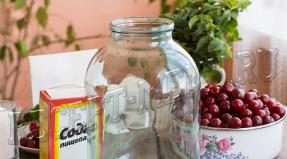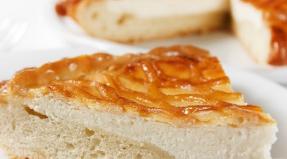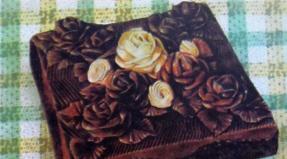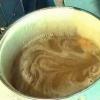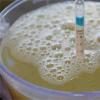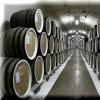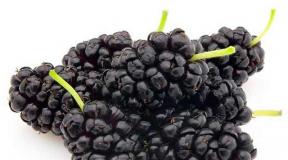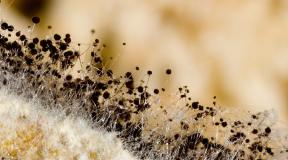How much yeast is needed for 4 kg of sugar. How much yeast is needed for mash
There are a huge number of recipes by which you can make home brew for moonshine at home. Without doubt, the most popular of these is the one based on sugar and yeast. This is what millions of our compatriots use. Thus, sugar and yeast mash can really be recognized as folk.
Making such a mash is a fairly simple process. Nevertheless, there are nuances in it that you need to know about. After all, the correct preparation of mash from sugar is a guarantee of the taste and quality of the obtained moonshine.
It is necessary to monitor the cleanliness of the dishes used in this process. Remember, you cannot use a galvanized bucket as a fermentation tank. Otherwise, harmful substances formed as a result of the oxidation reaction will get into the wash.
Classic recipe
Composition and proportions:
- granulated sugar - 1.5 kg;
- clean water - 4.5 liters;
- dry yeast - 75 grams or pressed - 225 grams;
- citric acid - 15 grams.
Thus, we received an answer to the main question of a novice moonshiner: "How much sugar, water and yeast do you need to take to make high-quality mash?" Having these proportions, it is not difficult to calculate the required amount of ingredients to make the required amount of mash. In our example, we get 6 liters of product. If, for example, we need 20 liters of mash, then we need to take 5 kg of sugar and 15 liters of water. The main thing is to observe the correct hydronic module. It is understood as the ratio of sugar to water in proportions of 1: 3, respectively.
Despite the fact that dry and pressed baker's yeast in our country is most often used to make wort for moonshine, they are not the best option. For everyone who wants to speed up the fermentation process, I recommend taking special alcohol yeast. They will allow you to get the final product ready for distillation as quickly as possible.
It should also be borne in mind that brewer's and wine yeast are not suitable for making mash.
Step by step sequence of actions.
Making mash from sugar is a process that can be divided into successive stages. Its duration depends on many factors. In particular, the yeast chosen for the recipe is of great importance. Thus, the mash can be cooked from 3 to 15 days.

1. Inverting granulated sugar.
First of all, one should not be intimidated by such a tricky word. Underneath is the production of regular sugar syrup. Practicing distillers may be surprised, as they are used to making mash directly from sugar. However, if you just make inverted sugar syrup once and put on a mash based on it, then you will always do so in the future. This will have the best effect on the final quality of the moonshine.
The fact is that the use of sugar syrup will make the fermentation much more active. This is understandable, because when heated, sugar breaks down into its components: glucose and fructose. It is these components that will process yeast into ethyl alcohol.
Follow these instructions to make a citric acid syrup. It's easy to invert sugar. Put a saucepan on a lighted burner, pour 3 liters of clean water into it and bring the liquid to a temperature of 74-79 degrees Celsius.
Add sugar slowly to the water. Stir the liquid while doing this. Make sure that it completely dissolves. We wait until the syrup boils, reduce the heat a little and keep the pan on it for 8-9 minutes. If necessary, remove the white foam with a slotted spoon.
After that, add citric acid to the syrup, make the fire as low as possible, cover the pan with a lid and keep it on the stove for 55-60 minutes. Then remove the syrup from the burner and cool it to 27-29 degrees Celsius.
At the same time, if you are not ready to spend so much time, then I advise you to dissolve granulated sugar in warm water. This is not a complete substitute for inverting, but it will also have a positive effect.
2. Mixing.

First of all, a few words must be said about the colossal role of the water used. It is difficult to overestimate its importance. It is best to take spring water. If you do not have this opportunity, do not be discouraged. Pure drinking water sold in any grocery store is quite suitable for mash. But it is not worth using liquid from the water supply.
Pour the prepared inverted sugar syrup into the fermentation vessel of your choice. Add the remaining 1.5 liters of water to it and stir. It is correct that the temperature of the mixture is between 28 and 31 degrees Celsius.
In addition, you should always remember that there must be enough free space in the fermentation tank (30-40% of the volume) for normal fermentation.
3. Prepare the leaven.
This stage completely depends on what kind of yeast you have chosen for making the mash. The packaging always contains instructions for their correct dilution. It must be adhered to.
As an example, I'll take a look at the steps to follow if you've chosen dry baker's yeast. We open the packaging, pour them into a small saucepan and add water with a temperature of 28-30 degrees Celsius. Stir, close the saucepan with a lid and wrap it in a blanket to keep warm. Remember dry yeast forms a copious foam. This is a normal process.
It is advisable to feed the sugar syrup before adding the activated yeast to the fermentation tank. If you do this, then the mash will ferment better. As a top dressing, take some malt, black raisins or rye bread and add the selected product to our container. Then pour the yeast solution, stir the liquid, install a water seal. The container should be transferred to a dark room with room temperature.
4. Fermentation.

The essence of this stage is simple. As a result of its normal functioning, yeast will process fructose and glucose into ethyl alcohol.
The chemical reaction of fermentation is always extremely violent. Its byproduct is the release of carbon dioxide. It is for its removal from the wash that you need to use a water seal.
As a rule, fermentation of the mash continues for 7-8 days. After this time, the processing of sugars into alcohol will be completed, carbon dioxide will cease to be released and the mash will become lighter.
To make sure that the mash is ready, I suggest you conduct two simple tests. First, light a match and hold it over the brew. If it burns quietly, then the first test is passed. Second, taste the mash. There should be no sweetness in it. On the contrary, a bitter alcoholic aftertaste with a slight sourness should prevail.
5. Degassing.
Drain the mash from the lees into a suitable sized saucepan. This is best done using a tube or hose. We put the pan on the stove and heat the liquid to 50-52 degrees Celsius. These actions allow you to simultaneously solve two problems: remove excess carbon dioxide and remove the remnants of the yeast culture from the wash.
6. Clarification.
White clay, also known as bentonite, will help us to carry out this stage. I recommend buying it in a specialized store. This is the only way we can be sure of the quality of the clay and its correct cleaning.
Take one tablespoon of bentonite and grind it. Pour in warm water and stir until a homogeneous viscous mass is formed. Add it to the cooked mash, mix and leave for a day.
Now we can proceed to distillation (distillation) of moonshine. Please note that the mash obtained according to the above recipe is not suitable for drinking.
In the comments, share your experience and ask questions.
Experienced moonshiners determine by eye the amount of ingredients for a high-quality strong and clean mash, as a result of which they get excellent quality moonshine. Our article is for those who are just mastering the skill of making a green snake. So, let's figure out what should be the mash made of sugar and yeast, the proportions, quantity and quality of ingredients.
The process itself, even at a stretch, cannot be called complicated. All the products are at hand, they are prepared simply and not for long, if the moonshine still does not fail, at the exit we get a clean, odorless and bad taste drink. In light of the huge amount of falsification, our article will be very useful.
We follow the rules and sequence
The most important thing in the cooking process is to precisely follow the rules of application and proportions. If you make a mistake in the calculations, the wort will turn sour and you will have to pour it out. If you make a mistake in the amount of yeast relative to sugar, nothing good will come of it either. Little sugar - mushrooms will not grow, develop and release waste products (ethyl alcohol, carbon dioxide and heat energy), which affects the final taste and organoleptic properties. A lot of glucose is even worse. Some of the mushrooms will remain after processing and subsequently, when distilled, they will give the final product a terrible smell and a disgusting stench even after the tails and heads are separated.

The second condition is clean, dry dishes. After each haul, it is necessary to thoroughly wash everything, starting from the container where the base is infused, and ending with the tubes in the apparatus. If you wash it "carelessly", mold will appear and you will end up with a product of little use for consumption. Moreover, even in the process of "mixing" the sugar mash, it can turn sour, and accordingly will have to be redone.
The fermentation temperature is also important - from 27 ° C to 31 ° C. At different times of the year, the temperature in the room changes, so it is convenient to use a conventional aquarium heater, selected by the volume of liquid. It is set at the desired mark and immersed in a can. We draw your attention to the fact that if the temperature is lower, the mushrooms will not develop, higher - the process of vital activity will occur too quickly without the release of the required amount of carbon dioxide.
The type and quality of yeast matters. Bakery products are of little use due to their low ethanol resistance and low alcohol content. On average, it is no more than 11 °, which affects the volume of sugar moonshine. During fermentation, bakers emit a large amount of carbon dioxide, which creates a lot of foam. During preparation, a third of the volume is left in the container. What is important is that this type of mushroom has a characteristic smell, which is also transmitted to the drink. Some people like the authentic spirit, but most prefer a pure and strong drink. We recommend choosing special - alcoholic yeast with minimum foaming and maximum volume of waste products. Wine or beer can be used with the same success.

And the last thing is the quality of the water. Ideally, it should be artesian, rich in sodium-potassium acids. Worse bottled. It is strictly forbidden to use boiled water - this is "dead" water, which lacks the environment necessary for the development of mushrooms.
What is a hydronic module
Making mash from sugar and yeast is best to start with theory. First, let's figure out what hydromodules are. This is the ratio of sugar to water in the wort. If you come across the phrase "sugar wash with 1: 5 hydromodule" it means that it is prepared from 1 part sugar and 5 parts water (large hydromodule). There is also a small hydromodule, where the proportions of sugar mash are 1: 3.5. The latter option is inconvenient, since the mushrooms do not have time to process the entire volume of glucose if bakeries are taken.
At an alcohol concentration above 12%, bread yeast "falls asleep" and precipitates. It is already an unusable product that must be disposed of.
It is another matter if alcohol grades are chosen that work at the maximum concentration of ethanol. On the contrary, a small amount of water in the wort is useful for them.

When preparing moonshine, it is better to focus on a large hydromodule (1: 5), when glucose is completely fermented, and the process itself is faster.
Often novice craftsmen are guided by the average hydromodule - 1: 4, but in this case there is a risk that the yeast will not completely win back, a precipitate will appear and glucose will not be completely processed.

Alcohol strains and turbo are preferable for a small module as they do not require a lot of water
In order to reduce this risk, here is a classic wort recipe:
- filtered or settled water during the day - 23.5-24 liters;
- sugar - 6 kg;
- alcoholic compressed yeast - 0.5 kg
This is a basic recipe, from which you will get an average of 4-5 liters of moonshine after double distillation or 2-2.5 liters of rectified (alcohol). Focusing on the average indicators and the volume of the can / keg, you can determine your volume. At the same time, please note that the basis is alcoholic yeast of Russian, Ukrainian or Belarusian production. European counterparts differ from the domestic product, therefore, when preparing, follow the manufacturer's instructions (as a rule, it is indicated directly on the packaging).
VIDEO: Sugar moonshine - what should be the correct mash?
Wort with baker's yeast
For most experienced moonshiners, bakery is a priority due to its characteristic aroma and aftertaste. We will not dispute such preferences, but we will give a classic recipe for such a product.

- general availability - they are sold in any grocery store, are inexpensive, stored for a long time;
- readiness number 1 - they do not need to be activated (started), it is enough to immediately dilute them in warm water, so that the fermentation process begins in a few minutes;
- instant reaction - even in the pressed product, the fungi are in an active phase, due to which they begin to react immediately if the water is warm;
- authentic taste and aroma - the result is a natural moonshine with a very distinct organoleptic properties, which distinguishes it from vodka.
- low strength - no more than 11 °, while when using alcohol (wine or beer) the concentration of ethanol exceeds 18 °;
- during fermentation, the wort must be "fed" - add a little bit so that they have time to process glucose;
- a characteristic odorant of both the wort itself and the finished drink - but this is a subjective view, many, we repeat, like it;
- the volume of foam reaches a third of the volume of the liquid - this is due to the abundant release of carbon dioxide, characteristic of a bakery product.
We evaluated the pros and cons, and if the latter, in your opinion, turned out to be less, we proceed to determine the proportions.
For one part of sand, you need 100 grams (dry granular) or 0.4 wet (pressed) yeast and four parts of water.
- artesian - 20 l;
- sand - 4 kg;
- pressed - 0.5 kg or 0.1 kg granular.
If you choose bakery, do not put a water seal on the can for the first 3-4 days until the main wave of foam subsides. Then you install it and use it as usual.

Please note that granular is always added 5 times less than wet (pressed). This is a prerequisite to exclude the formation of a precipitate or an insufficient volume of ethyl alcohol.
Wine and beer halls - how to handle them
Today, a wide variety of yeasts are sold - bakery, alcoholic wine, brewery and even wild - those that are harvested from the surface of berries and cereals. Each of them is a whole colony of living mushrooms, which grows in a favorable environment and secretes waste products. It is ethyl alcohol, carbon dioxide and heat in different proportions. Depending on the variety, the proportion changes, but the composition remains unchanged.

Some home-brewers prefer to use wine colonies at home. This is a milder version of alcohol, in which the fermentation process increases to several weeks, but all glucose is processed, there is almost no residue, the organoleptic is very pronounced, which affects the final taste.

The disadvantage of wine strains is that they consume sugar slowly, so they are not suitable for making pure sugar mash - you must definitely feed the wort with fruits or cereals
- artesian or filtered water - 20 liters;
- sugar - 4 kg;
- wine or brewer's yeast - 10 kg.
Please note that in its pure form, such a base is too scarce for a wine product, fungi develop in the presence of fructose. Periodically, during the ripening process, the wort will have to be "fed" with pomace or fresh fruits, fruit juices, preserves, and marmalades. It is not worth adding a lot of enzymes, the main thing is that the development continues.
From the very first day of preparation, the wort can be placed on a keg or a canister with a water seal - foam formation in this colony variety is minimal.
Taking into account the fact that fruits and / or cereals will be used in the manufacture of mash, before driving it, it must be filtered and cleaned with bentonite.
The finished drink will turn out to be strong, clean and pleasant to the taste, but without the authentic smell of bread. And this will be the right moonshine!
VIDEO: Secrets of the master - the correct preparation of the correct brew
Our compatriots are happy to be engaged in home brewing, as a result of which the question becomes quite logical. And how to make home brew for further distillation of moonshine? In fact, everything is simple, the mash is made from sugar and yeast. Below we will consider the main aspects, namely the fermentation temperature, cooking mash from sugar and yeast, proportions and other important nuances.
Making mash for moonshine from sugar and yeast - preparation
To get 1-1.1 liters. the final mash with a strength of about 40 degrees, you need to take 1 kg. granulated sugar.
# 1. Tableware
Before you put sugar and yeast mash, take care of the necessary utensils. When choosing, pay attention to the volume, the brew does not occupy the entire cavity, but only 75% of the container. If you fill the fermentation vat to a larger volume, then the frothy head will go beyond the container.
No. 2. Material
The ideal material for making mash is glass. These can be bottles or cans that are at hand. Also stainless steel, food grade plastic, aluminum saucepan, etc. are suitable. Try to choose a container that is equipped with a drain cock. This will make it easier for yourself.
No. 3. Sterilization of containers
Be sure to sterilize the container by rinsing with boiling water and washing with soda. In the future, it is necessary to thoroughly dry the entire inventory so that not a drop of moisture remains. If the brew turns sour, the moonshine will have an unpleasant aftertaste.
No. 4. Water
The taste of the final drink and the absence of an unexpected result depend on water. Therefore, use bottled or spring (ideal). It is allowed to cook the mash in running tap water, but it must be defended for two days without a lid. Now the hydromodule (proportions of sugar and water in the wort) is 4 liters. water is supposed to be 1 kg. granulated sugar.
Selection of yeast for mash
Since mash for moonshine can be made according to the traditional recipe from sugar, water and yeast, great attention is paid to the choice of the last component.
Buy alcohol yeast, read the instructions on the back of the package. It indicates the ratio of sugar and yeast for mash. The main disadvantage of such products is the rarity and pricing policy.
If you do not find alcohol, buy powder (dry). Then the proportions will be as follows: 1 kg. granulated sugar is allocated 20 gr. dry yeast.
Pressed can also be used, for 1 kg. sugar is supposed to be 100 gr. such yeast.
Mash recipe for moonshine from sugar and yeast: "a classic of the genre"
According to the traditional recipe, you will get about 5.5 liters. purified moonshine when the second fractional distillation is carried out. The alcohol content is 45 degrees.
- water - 20 l.
- granulated sugar - 5 kg.
- dry yeast - 100 gr.
Before making the right mash for moonshine, read the step-by-step instructions for making a "potion" from sugar and yeast.
Stage 1. Wort boiling
1. Place the fermentation container on a stool to improve heat transfer. Pour water preheated to 28 degrees into the dishes, add granulated sugar in the amount according to the recipe. Start stirring until the granules dissolve. If you have a sugar meter, use it to measure the sugar concentration in the wort (a good indicator is 18-22%). If not, skip this step and move on.
2. Now activate the yeast in a separate bowl. To do this, pour 0.3 l into a bowl. water, warming it up to 28 degrees. Pour in 30 g. granulated sugar, stir. Pour in dry yeast, leave for a quarter of an hour. When they rise, pour them into a fermentation vessel. If the foaming is strong, it can be reduced by adding Saf-moment yeast in the amount of 11 grams. If you decide to use compressed yeast, you need to take it in an amount of 0.5 kg.
3. For the yeast to work in full force, it is desirable to "feed" them. An optional but highly desirable point. From top dressing, you can choose raspberries, grapes, strawberries (20 berries for the entire specified volume of mash). Black bread (1/2 loaf) is also suitable.
4. We continue to tell you how to make home brew for moonshine. When cooking with sugar and yeast, it is not at all necessary to use a water seal. Just screw the cap loosely or, if there is a small neck, cover it with 3-5 layers of gauze.
Stage 2. Fermentation
1. Ensuring the correct temperature is essential for the wort to ferment properly. The optimal indicator is considered a mode in the range of 27-30 degrees. Do not under any circumstances exceed the temperature, otherwise the yeast will disappear, fermentation will stop.
2. Not everyone has the ability to maintain the specified mode, so use a heater for an aquarium, they are available from 50 watts and above. Your mash volume is 20 liters. a device with a capacity of about 50 watts is enough if the wort is in a warm room.
3. A positive feature of such a device is the stability of heating. It is enough to set the heater to 28 degrees and immerse it in the wort, then connect it to the mains.
4. Many are interested in how much mash ferments on sugar and yeast. If all conditions are met, this process takes 1-2 weeks. It is imperative to stir the mash 1-2 times a day to eliminate carbon dioxide.
Stage 3. Definition of readiness
In the question of how to make mash for moonshine, it is very important to determine its readiness in a timely manner. In a recipe made from sugar and yeast, the following conditions must be met.
1. Carbon dioxide has ceased to come out, the water seal does not boil. There are no bubbles on the surface of the mash. You need to light a speech and hold it over the mash. If the light is not extinguished, it means that carbon dioxide is no longer emitted.
2. When ready, the mash exfoliates, becoming lighter in the upper part. In this case, the yeast sinks to the bottom, forming a sediment.
3. Another important condition for readiness is taste. The brew becomes bitter, the sweetness is lost. The finished mash smells like alcohol.
4. To be sure that fermentation is complete, you need to use a sugar meter. After fermentation of the wort, the device will show the value "0".
Stage 4. Mash cleaning and clarification
1. This stage is carried out in order to improve the taste of moonshine. To remove the rest of the carbon dioxide, put the mash on the stove and heat it to 55 degrees.
2. To lighten the mash, leave it for 2 days at a temperature from -5 to +5. You will see that the yeast has precipitated. All that remains is to drain the composition from the sediment using a thin silicone hose.
3. Braga can be clarified and cleaned with bentonite. It is understood as a completely natural composition, that is, white clay. Buy Pi-Pi-Bent products, add 3 tbsp. l. 20 liters. mash and wait a day. After this period, remove the final product from the sediment using a hose.
Now you know exactly how to make mash for moonshine. According to the recipe described above, it is made from sugar and yeast, which is considered a classic. Therefore, feel free to follow the instructions and everything will work out!
Braga from sugar and yeast, the proportions of which are calculated depending on the timing of the fermentation process, is prepared in compliance with the technology. Cooking requires accurate calculation of ingredients, temperature compliance and constant monitoring.
Water is a vital medium for their existence, therefore, its choice must be approached carefully. The quality of the water determines the taste of the drink. It should be transparent, clean, free from foreign taste and odor.
It is preferable to choose soft water, which contains minimal amounts of magnesium and calcium salts. Raw (unboiled) water from a spring or artesian well is suitable for making mash. In no case should you use boiled water.... It lacks the dissolved air bubbles necessary for the yeast to function.

This process, associated with the breakdown of sucrose into fructose and glucose, is accompanied by a fruity odor reminiscent of artificial honey. The use of inverted syrup increases the quality of fermentation and reduces the amount of waste from the distillation of mash.
Alcohol yeast
An important ingredient in the mash preparation process is yeast - unicellular fungi that live in liquid substrates rich in organic components. Their use for making moonshine is based on the characteristics of metabolism.
In a liquid medium, under the influence of enzymes, they can convert sugar into alcohol and carbon dioxide. They use organic compounds as a source of carbon and for energy production.
For the preparation of mash, it is better to use alcoholic yeast, the advantage of which is its increased viability in an alcoholic environment. This type of yeast allows you to achieve the concentration of alcohol in the mash at the level of 15-18%.

Their use allows you to speed up the fermentation. In the ripened mash, the content of impurities decreases:
- fusel oils;
- acetone;
- aldehydes.
When using alcoholic yeast, the problem of cleaning the final product does not become the main one, and the fermentation process takes place without the formation of abundant foam.
Yeast producers offer special alcoholic yeast containing additives in the form of vitamins, trace elements, amino acids. Their presence allows you to accelerate fermentation due to additional nutrition of the yeast.
Step-by-step cooking instructions
The recipe for mash from sugar and yeast for 20 liters contains components in the following quantities:
- Yeast - 400 g;
- Sugar - 3.4 kg;
- Water - 16 liters.
Sugar is added to the water, the temperature of which for cooking the mash should not exceed 24 ° C. The solution is stirred until the crystals are completely dissolved. Next, yeast is added. All components are carefully connected. After that, the container is closed with a hydraulic seal.
If pressed, you can add dry yeast. They are taken at the rate of 150 g per 8 kg of granulated sugar. Before adding them to the solution, you need to dissolve them in water heated to a temperature of 32 ° C. For 150 g of yeast, 0.5 liters of water is required.

Capacity requirements
The taste of the final product directly depends on the material from which the container is made. When choosing it, one must be guided by the criteria for assessing the quality of the material, volume, tightness of the container.

For an optimal fermentation process, you must strictly adhere to the cooking technology and observe the proportions of the components. As a result, the resulting moonshine will be of the highest quality.
Cooking technology
The starting material for the production of alcohol is a liquid formed as a result of fermentation of an aqueous solution of sugar with yeast. The process of their vital activity is accompanied by the formation of alcohol with the release of carbon dioxide. 
- Mash can be made from various raw materials which contains sugar. When making liquid for distillation from starch-containing ingredients, they are first saccharified (broken down to simple sugars) under the influence of synthetic or artificial enzymes.
- Depending on the cleavage temperature, a distinction is made between cold and hot methods.... An important stage in the technological process is fermentation, which results in the decomposition of sugar into alcohol and carbon dioxide.
- In order to make high-quality mash from sugar in the shortest possible time, you need to create the necessary conditions for fermentation, ensure the temperature for the process is at + 18-24 ° C.
- Various ingredients can be used to make mash, but mainly yeast, sugar and water are used. The proportions, as evidenced by the practice of home brewing, are calculated individually, depending on the preferences of the manufacturer.
- If the fermentation process needs to be accelerated, then the amount of yeast is increased. But their excess can negatively affect the quality of the final product.

Braga for moonshine from sugar and yeast can be easily made independently. The cooking process itself is quite simple. In order for the mash for moonshine from sugar and yeast to be of high quality, you just need to know a few simple rules. And of course - these rules should be followed.
The first rule is the cleanliness of the room and the dishes in which the mash is made. The second rule is choosing the right yeast. The third rule is to maintain the required temperature in the room. It is worth remembering that at temperatures above thirty-five degrees, yeast (which is a living organism) dies. And finally - the fourth rule, which implies strict adherence to the recipe and the observance of proportions.
Read also:
Braga from sugar and yeast proportions or making a mash in detail.
Basically, it is the components mentioned above that are used to make mash. The cooking process itself does not have any special subtleties, however, the question of proportions remains controversial. The proportions, as practice shows, can be very different, depending on the tastes of the manufacturer himself. But where is that famous golden mean?
In the case when the production time does not allow the mash to ferment in the usual way, to speed up the fermentation process, you can increase the amount of yeast. However, you should not just abuse yeast - its excess can affect the quality of the final distillation product, that is, moonshine. If you insist on the mash for 15 days, (there is simply no need for longer) and the amount of yeast is left normal, then the drink will turn out to be transparent and clean. As a result, it will only be necessary to carefully drain it, leaving the sediment in the container.
Braga from sugar (recipe) video
To prepare classic mash, the following components are required:
- Sugar;
- Water;
- Yeast;
- Potatoes (raw).
How many of these components should you use? It depends on how much of the final product (in this case, moonshine) is planned to be made. The indicator of the strength of the finished drink is also important.
For example, in order to make ten liters of moonshine with a strength of 40-45 degrees, you must use:
- Raw potatoes - three pieces,
- Sugar - 8 kilograms
- Raw pressed yeast - half a kilo and of course - water.
- It will take about 20-25 liters.
However, there are other opinions regarding proportions. Many moonshiners use a 4 to 1 ratio for cooking, and not 3 to 1, as indicated above. That is - 32 liters of water and 800 grams of yeast for the specified amount of sugar. It is worth noting that the mash does not get worse or better from this. The only drawback is that the specific volume of the distillation product increases. It is simply impossible to overtake it in an average cube of 40 liters in one sitting.
Usually the recipe for mash made from sugar and yeast for 20 liters of mash is as follows:
- 16 liters of water;
- 400 grams of yeast;
- Sugar 3.4 kg
The water should not be boiled, but at the same time it should be clean. When adding sugar, stir the solution in order to avoid crystallization. Next, you need to add yeast.
In this case, the water temperature should not exceed 24 degrees. After that, you need to take a mass of raw grated potatoes (1-2 pieces) and also throw it into the mash. Although you can do without the last component.
After that, cover the container with a lid (not tightly!) And wait. Accordingly, if you think about how the mash is made for moonshine from sugar and dry yeast, the proportions of 40 liters should be taken similar, but the amount of raw materials should be twice as high.
If raw compressed yeast cannot be obtained, dry yeast can be used. But in what proportions should this product be used? Usually they are calculated in about 1 to 5 or 6 parts. This means that 8 kilograms of granulated sugar will require about one and a half bags of yeast (if you take into account the capacity of the bags - 100 grams each). Such yeast is stored much longer, and much less of them is required, which are peculiar and often significant advantages.
To use this type of yeast, you need to fill them with water at room temperature or lukewarm (up to 32 degrees). Water for 150 grams of yeast will take about half a liter. The resulting mixture must be stirred evenly until the granules are completely dissolved. After which it should be infused for about an hour. After that, the starter culture can be poured into a bowl with a mash blank.
Contrary to popular belief, the mash made from such yeast is in no way inferior in quality to that made from raw. But after completing the preparatory process, that is, preparing the solution, you should be prepared for the mash to behave in an extremely unpredictable way. Basically, the fermentation process takes place quite calmly, but there are also cases when the mash begins to foam intensively.
In this case, do not try to tightly close the lid of the vessel - the wash may explode. To prevent such unpleasant consequences, it is necessary to have a bottle with any vegetable oil or milk nearby. If the wash begins to foam, you just need to add a little (about 30-40 grams) of oil to it.
This operation may have to be performed several times. Therefore, it is worth periodically observing the container with the workpiece. It usually foams within 24 hours after souring. Yeast begins to revive about an hour after its completion. In no case should you try to kick the foam off the surface by hand. The mash calms down 3-4 days after preparation.
After that, you can add water to it and transport it to a warmer (with a temperature regime of 28-35 degrees) place to continue the fermentation processes. Some mash manufacturers at this stage recommend closing the container, stopping the access of air into it. Although, this has no effect on the quality of the final product.
In the process of cooking, the mash gradually brightens. The clarification process begins after about a week. The lighter the drink, the more readiness it is. After about 7-10 days, you can taste it. If the mash has a sweetish taste, it must be moved and allowed to stand for a few more days. Ideally, the drink should be bitter.
In addition to sugar, for making mash, you can also use the following substitutes:
- Rice (0.59);
- Apples (0.06);
- Pears (0.07);
- Beets (sugar - 0.03-0.12);
- Cherry (0.05);
- Starch (0.72);
- Buckwheat (0.47);
- Wheat (0.43);
- Oats (0.36);
- Rye (0.41);
- Millet (0.41);
- Peas (0.4);
- Barley (0.34);
- Potatoes (0.11-0.18);
- Grapes (0.9-0.14), etc.
Specific alcohol yield per kilogram of base is indicated in parentheses. The alcohol yield from sugar is 0.51. Looking at the above data, we can conclude that this is far from the highest indicator.
Regarding the volume of the container, we can say that its volume should be 20-25 percent more than the volume of the workpiece. Such a safety margin of space is necessary so that in the event of excessively intense fermentation processes and, as a consequence, the appearance of foam, the mash could not get out of the container.
Today in stores and markets you can buy special barrels, the volume of which can be very diverse. Rectangular containers are ideal, as they take up much less space and are more convenient for storage. When buying a container, you should make sure in advance that it meets all the necessary requirements and that food products can be stored in it.
If you plan to constantly engage in the distillation of mash, you should purchase containers for distillation and fermentation in advance. As the first, a flask made of aluminum, with a volume of about forty liters, is suitable. This flask is often called a cube. It is suitable for a one-time distillation of about thirty liters of mash, which is ¾ of the total volume. That is, the above space should be left here as well.
